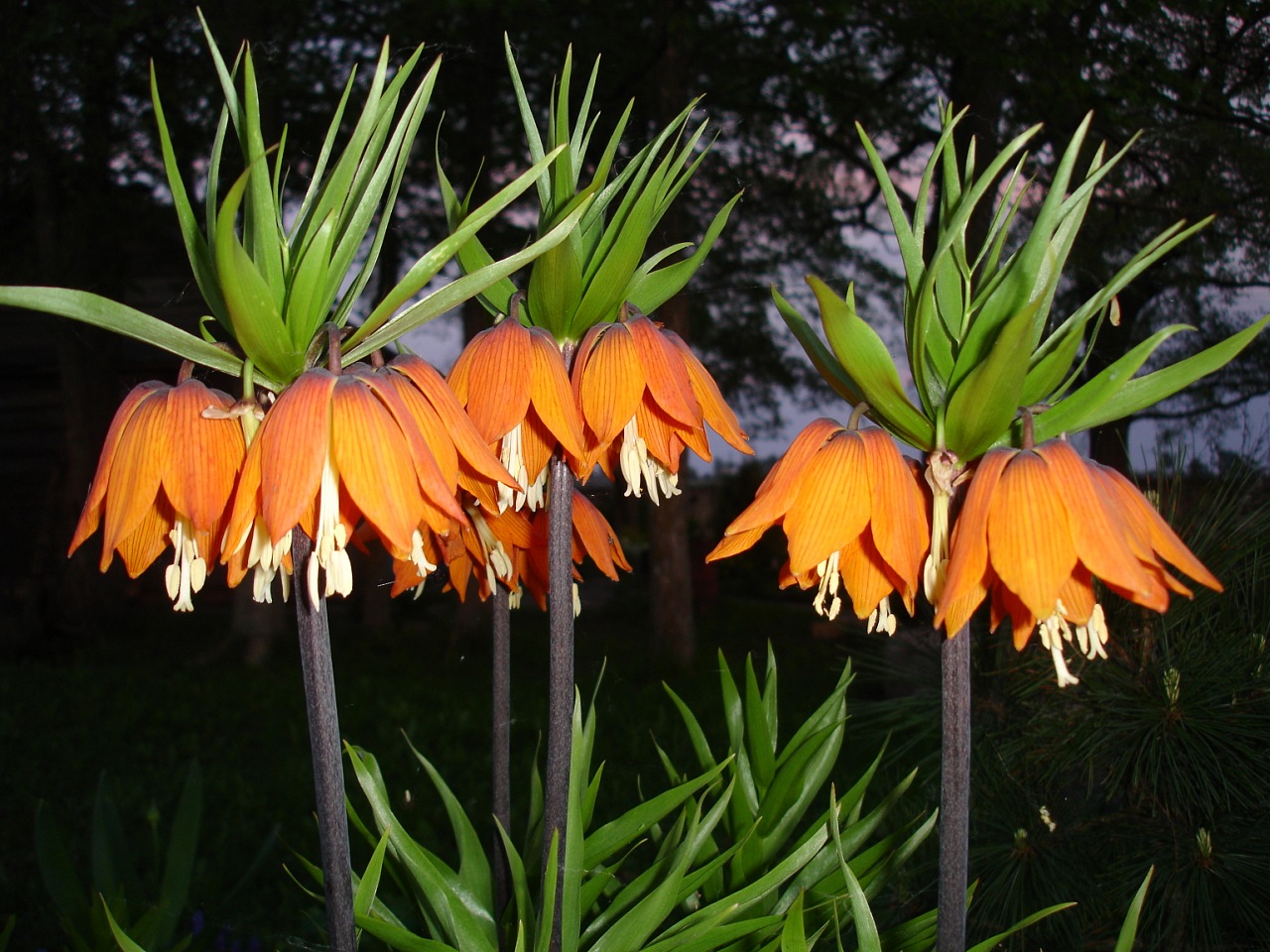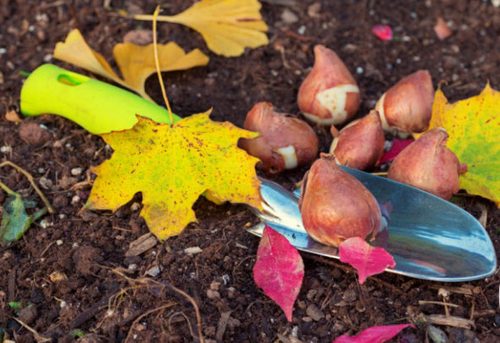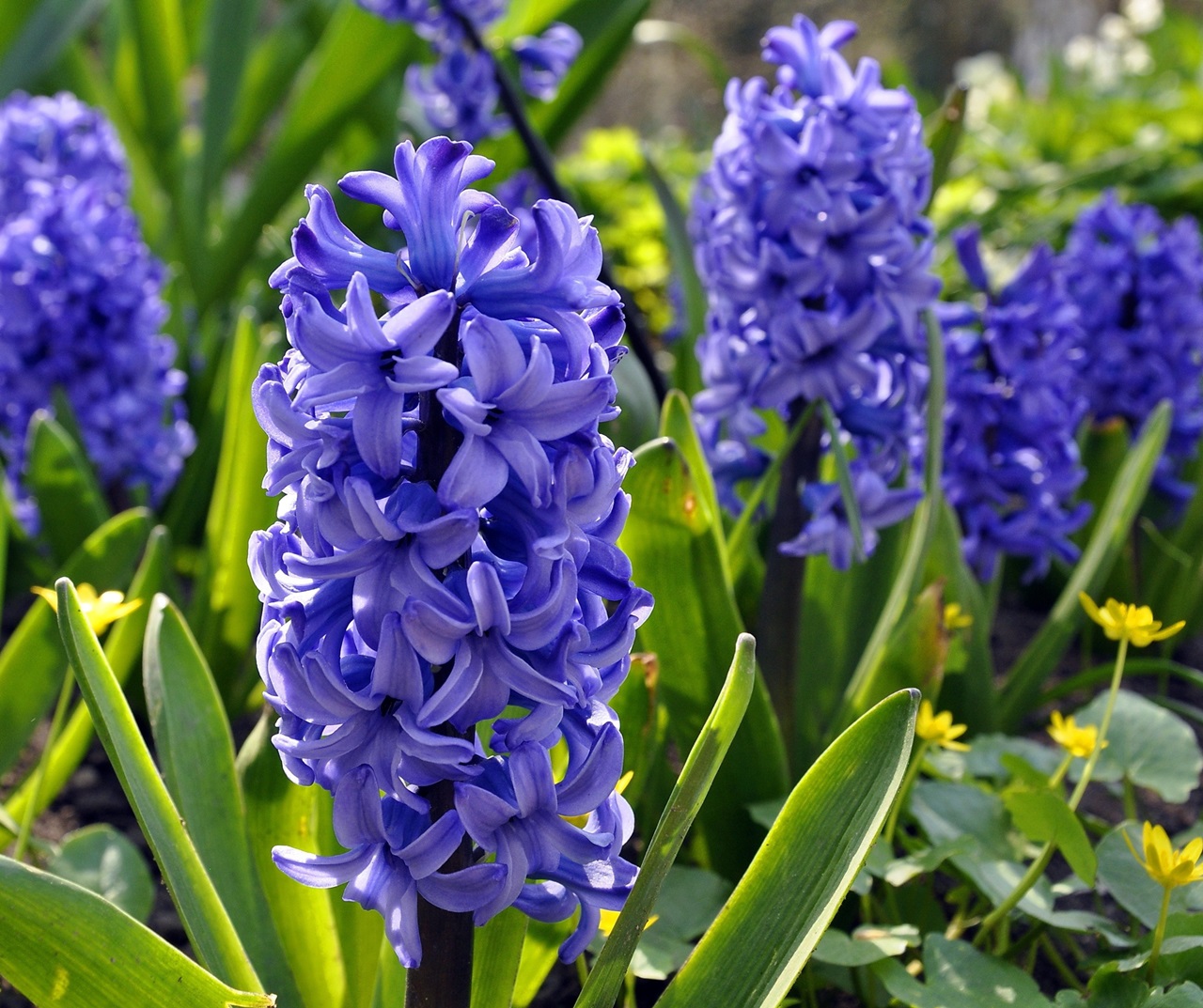A surprisingly beautiful crocosmia plant will be able to compete with many bulbous plants. The flower, whose homeland is South Africa, has long been grown in the gardens of our country. Its bright green leaves appear at the very beginning of spring, and in summer crocosmia adorns the garden with its beautiful flowers with a warm range of shades. The plant is unpretentious in care, but planting and growing it requires adherence to some recommendations.
Content
Crocosmia: general description, varieties, photos
Japanese gladiolus, montbrecia, crocosmia are all names for one attractive bulbous plant with long stems and lily-like flowers. Depending on the variety crocosmia reaches a height of 60 to 150 cm. Its leaves resemble iris leaves, and paniculate inflorescences consist of yellow-orange or red flowers.
The following varieties of montbrecia are used to compose compositions in garden plots:
- Crocosmia golden in nature grows in the forests of tropical regions. The plant grows up to 70-100 cm in height and is distinguished by basal xiphoid or linear leaves. Flowers are yellow-orange in length up to 5 cm. Since montbrecia is a golden forest plant, it is recommended to grow it in slightly shaded areas. It blooms in autumn, used for making bouquets.
- Crocosmia Masonorum grows up to 60–80 cm, has large bulbs and corrugated xiphoid leaves. It blooms for a long time with small flowers blooming in summer.
- Montbrecia Posta adapts to almost any adverse conditions. In nature, it grows in wetlands and along the banks of the rivers of South Africa. Differs in smooth narrow leaves and small flowers.
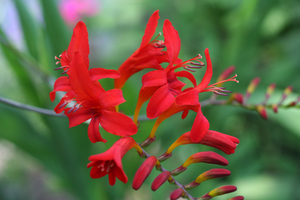 Crocosmia Panikula blooms with small orange flowers in early summer. Differs in corrugated leaves and frost resistance.
Crocosmia Panikula blooms with small orange flowers in early summer. Differs in corrugated leaves and frost resistance.- Montbrecia Lucifer is a hybrid species that has a wide variety of colors. They can be bright or pastel colors. The species is widely used to decorate flower beds, flower beds and create compositions in the garden.
Crocosmia: planting and care in the open field
Growing Japanese gladiolus is identical to planting and care of many bulbous plants in open ground... However, there are some differences. So, for example, the planting material of montbrecia is prepared a few days before disembarkation:
- Bulbs stored in a cool room in the winter season must be peeled, dried and kept warm for several hours.
- The dried planting material is soaked for two hours in a solution of potassium permanganate.
- In late April - early May, depending on the region, the bulbs are planted in open ground. Since the plant is thermophilic, the minimum soil temperature during planting should be at least + 5C. It is checked at a depth of 10 cm.
Depending on the weather conditions of the region, crocosmia can be planted directly in open ground or grown at home first.
Planting montbrecia in open ground
Japanese gladioli love open sunny areas... They can be planted on unprotected hills, since they are not afraid of the wind.
The soil for planting a plant must be prepared in the fall. The soil is dug up shallowly and fertilized with superphosphate. Per square meter of land you should take 30-40 grams of fertilizer. Potassium chloride and nitrogen can also be added to nutrient-poor soils. Clay soil is lightened by small pebbles and sand.
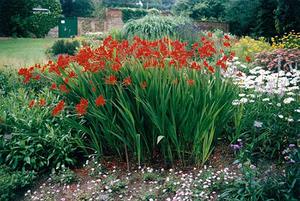 Since crocosmies do not like stagnant moisture, the following is added to the soil in equal proportions:
Since crocosmies do not like stagnant moisture, the following is added to the soil in equal proportions:
- peat;
- sand;
- compost.
Everything is mixed and placed in the prepared holes with a layer of 15 cm. The planting material is distributed over the laid out "pillow", sprinkled first with sand, and then with an earthen mixture from the site.
Large bulbs should fall into the holes by about 10 cm, and small ones - by 5 cm. The distance between them depends on the size and can be 5-15 cm. Distance between gladioli of different varieties must be at least 80 cm, otherwise they can become overdusted and lose their varietal qualities.
Growing crocosmia seedlings
Planting bulbs for seedlings should be carried out in large containers, which are filled with moist peat or sawdust. At a short distance from each other planting material is laid out on a layer 4-5 cm thick... The containers are covered with glass or polyethylene from above. Seedling care consists of daily airing the bulbs and keeping the soil moist.
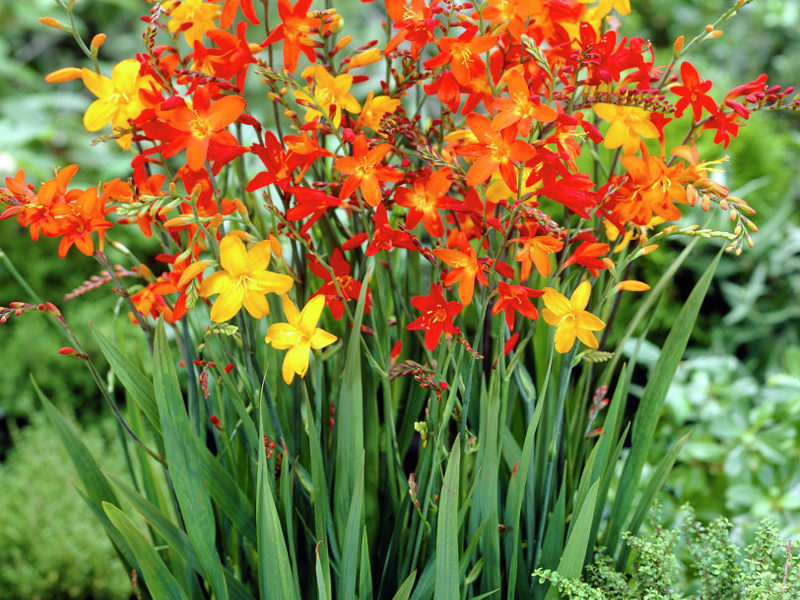
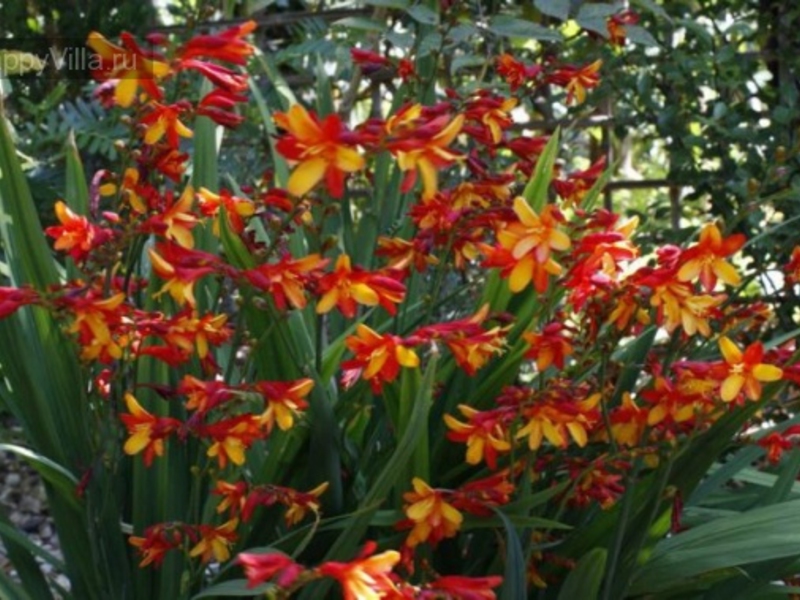
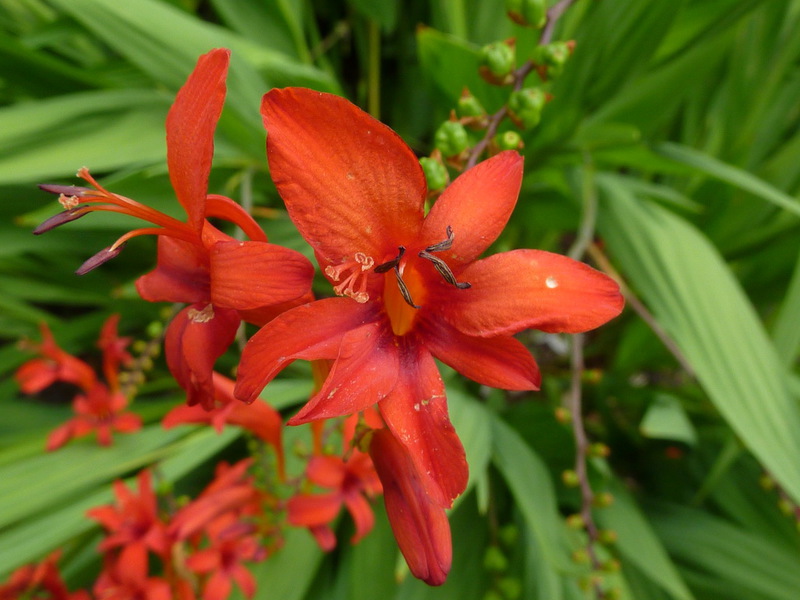
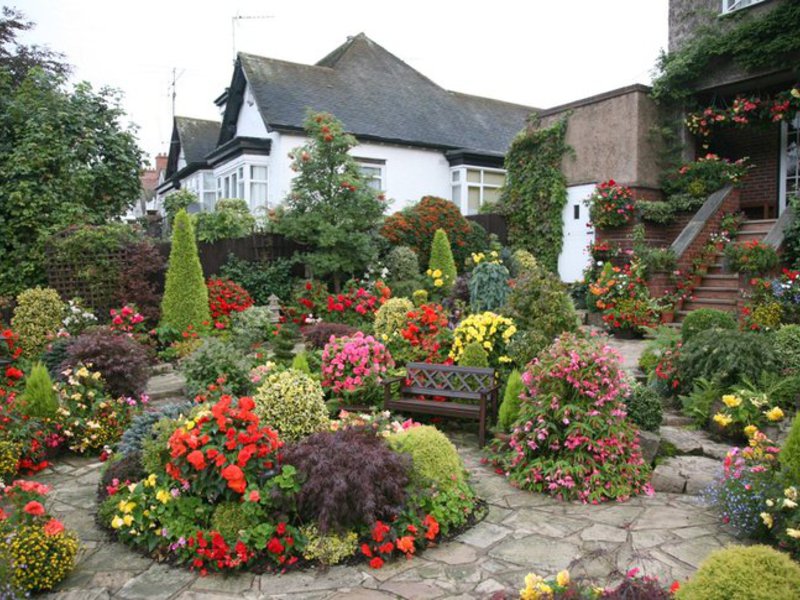
In order not to remove the polyethylene from the boxes every day, small holes can be made in it for ventilation. It is not recommended to water the bulbs; it is best to moisten them by spraying with water at room temperature.
As soon as sprouts appear, the bulbs are planted in separate pots filled with earthy mixture. In them Crocosmia seedlings will grow within two to three weeks. In open ground, seedlings are planted from mid-May to early June, when the threat of frost passes and the soil warms up.
Care features
Montbrecia is unpretentious and does not require special care. During the season her 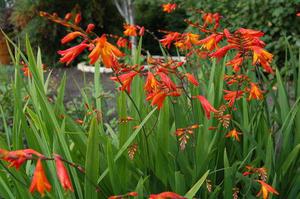 need to water regularly, but so that there is no stagnant water in the soil.
need to water regularly, but so that there is no stagnant water in the soil.
Three times a month, Japanese gladioli are fed with mineral fertilizers, which alternating with watering plants with infusion of bird droppings or cow dung... The first feeding is done when the leaves appear. In autumn, montbrecia is fed with potash fertilizers.
When caring for a tall plant, it is recommended to tie up long peduncles to pegs, otherwise they may break under the weight of spike-shaped inflorescences. To ensure the flow of nutrients to the rhizomes, it is recommended to cut out the faded inflorescences in a timely manner.
Crocosmia in winter
Depending on the type and variety of plants, montbrecia can remain outdoors for the winter, or be dug up and stored indoors. Are not afraid of frost mostly small-flowered forms that, with good shelter, do not freeze even in the middle lane. They are first covered with foliage or sawdust, which are covered with a film from above.
It is best to dig up Japanese gladioli with large flowers for the winter. It is recommended to do this in the second half of October, since the children need to be given time to mature. Planting material is dried in a well-ventilated area and is laid in peat, sand or sphagnum. Babies are not separated from the mother's bulb, otherwise they may dry out. Bulbs are stored at a temperature not exceeding + 10C. If there is no such room, then you can use the vegetable section of the refrigerator.
Reproduction of crocosmia
The bulbous plant reproduces both by seed and vegetative means.
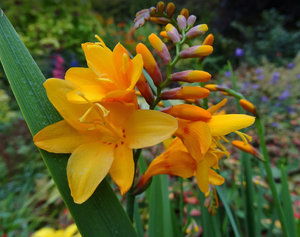 Large seeds of montbrecia are sown in containers filled with earthen mixture and placed in a warm place for germination. When the first seedlings appear, they must be transferred to a well-lit place. Seedling care consists in timely moistening of the soil and planting grown seedlings in separate pots. Seedlings are planted on the beds in mid-May. Plants grown from seeds will bloom in the second or third year.
Large seeds of montbrecia are sown in containers filled with earthen mixture and placed in a warm place for germination. When the first seedlings appear, they must be transferred to a well-lit place. Seedling care consists in timely moistening of the soil and planting grown seedlings in separate pots. Seedlings are planted on the beds in mid-May. Plants grown from seeds will bloom in the second or third year.
When crocosmia is propagated by bulbs, babies are separated from the mother bulb in the spring and planted in open ground in holes prepared in advance. In the second year after planting, they will bloom.
Diseases and pests
Montbrecia is most often affected by thrips and bears. When found on shoots and leaves of thrips, the plant must be treated with special chemicals, from which the solution is prepared according to the instructions.
Bears cause great harm to crocosmia. Pests like to gnaw on bulbs, as a result of which the plant starts to hurt, its leaves wither, and corms rot. To combat the bears, special preparations are used:
- "Thunder";
- "Grizzly";
- "Medvetox".
But the use of only such means will not completely eliminate pests, since they constantly fly from one area to another. Isolate a special repeller will help from the bearwhich can be purchased at garden stores.
The refined and graceful crocosmia inflorescences will decorate the summer and autumn flower beds of the garden plot with bright colors. They will look spectacular as in a single landingand among chrysanthemums, echinacea, dahlia, cannes and daylilies.
